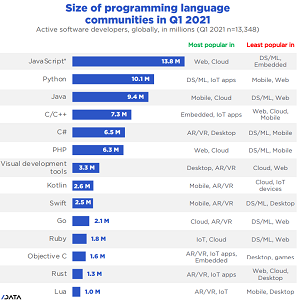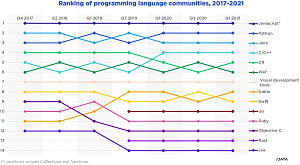News
Survey Reveals Bigger C# Community, Most and Least Popular Uses
Polling more than 19,000 developers, the new "Developer Economics State of the Developer Nation, 20th Edition," report is out, finding that C# has ticked up a notch in popularity, overtaking PHP for No. 5 on that ranking. What's more, the big twice-yearly report identifies what areas are most and least popular for coding in Microsoft's flagship programming language.
While previous SlashData reports ("C# Slides in Usage Ranking of Programming Languages" and "Developer Report: 'C# Seems to Be Losing its Edge in Desktop'") noted decreases in popularity, this one reports an uptick.
 [Click on image for larger view.] Programming Language Communities (source: SlashData).
[Click on image for larger view.] Programming Language Communities (source: SlashData).
"C# lost three places in the rankings of language communities between Q3 2019 and Q3 2020, but it regained its lead over PHP in the past six months after adding half a million developers," the report states.
As the chart below shows, C# fell from its accustomed No. 4 slot (measuring the size of a language's community) in 2019 before rebounding one step in the latest report.
 [Click on image for larger view.] Programming Language Communities Over Time (source: SlashData).
[Click on image for larger view.] Programming Language Communities Over Time (source: SlashData).
As far as usage, the language is popular for augmented reality/virtual reality (AR/VR) development and desktop development: "C# is traditionally popular within the desktop developer community, but it's also the most broadly used language among AR/VR and game developers, largely due to the widespread adoption of the Unity game engine in these areas." Coincidentally, Unity just recently detailed its plans for .NET and C# regarding the gaming-centric real-time development platform.
It was a different story one year ago, when the 18th edition of the report said: "C# lost about 1M developers during 2019. C# is an important language in the AR/VR (Hololens) and game developer ecosystems, but it seems to be losing its edge in desktop development -- possibly due to the emergence of cross-platform tools based on web technologies."
The language might see more desktop development inroads as new initiatives from Microsoft such as Blazor Desktop (one of those "cross-platform tools based on web technologies") and .NET MAUI provide a wide array of desktop approaches ("Microsoft Details 9 Desktop Dev Options, from WPF to Blazor").
Other than those brief mentions of C#, the report doesn't have much else of special interest to readers of Visual Studio Magazine. There's no section on tools like the Visual Studio IDE or the Visual Studio Code editor. Microsoft's other prominent language, TypeScript, was included in the JavaScript category (along with CoffeScript), which many such reports don't do, rather separating TypeScript from JavaScript. Also, the term "Microsoft" was only mentioned once, as a sponsor.
Here's a high-level, bullet-pointed list of other key insights gleaned from the report, focused on six major trends, as presented by SlashData:
-
Programming language communities -- An update:
- JavaScript is the most popular programming language by some distance, with nearly 14M developers using it globally.
- Since it surpassed Java in popularity at the beginning of 2020, Python has remained the second most widely adopted language behind JavaScript, with just over 10M users.
- Google's preferred language for Android development, Kotlin, has grown more than two-fold in size since the end 2017.
- Rust and Lua were the two fastest growing languages communities in the past year.
-
Machine learning developers and their data:
- With 68 percent usage, unstructured text data is the most common type of data that machine learning (ML) developers and data scientists work with.
- The majority (53 percent) of ML developers and data scientists are professionals -- although, in some cases, they might be also involved in hobby or student projects in parallel.
- 65 percent of those who are exclusively students use one or two types of data, while 61 percent of exclusively hobbyists and only 54 percent of exclusively professionals use one or two types. Very large training datasets aren't perhaps as ubiquitous as one might expect.
-
On the influence of developers:
- A substantial 75 percent of hands-on developers and 92 percent of developer team leads are, to some extent, involved in tool buying decisions.
- Developer team leads are particularly influential in their role. 63 percent of them make recommendations or influence their company's decision makers.
- Highly experienced, hands-on developers without a lead role are deemed to be as influential in purchasing decisions as product managers.
-
Emerging technologies:
- Adoption of mini apps is on the rise, as developers recognize their broad, practical applications.
- Blockchain applications attract developers on an academic level, and there remain many opportunities for commercial adoption.
- Brain / body computer interfaces sit in the sci-fi realm, along with quantum computing and self-driving cars.
- Low engagement and adoption of hearables, DNA computing / storage, and haptic feedback demonstrate the nascent nature of these technologies.
-
On COVID-19's current and lasting effects:
- 37 percent of developers say that the pandemic changed nothing in the way they work, and 43 percent in the way they study.
- Developers working for large companies were more likely to go fully remote during the pandemic.
- Junior developers were affected the least by the pandemic in the way they work.
- Switching to remote working has been more common in Western regions.
- Younger learners, most likely those who are studying for a formal degree, were the most affected in the way they learn.
-
Embedded software -- An overview:
- One in 10 developers work on embedded software projects.
- Embedded developers are more likely to also be involved in industrial IoT, consumer electronics, augmented reality, and virtual reality than developers not involved in embedded software.
- Most embedded developers target desktop environments with their code, but these developers are less likely to also target other environments.
- C++ is the most popular programming language amongst embedded developers -- it's used by 40 percent of them.
The report can be downloaded for free upon providing registration information, from here. Methodology for the report -- based on a survey of more than 19,000 developers from 155 countries conducted from November 2020 to February 2021 -- is explained here.
About the Author
David Ramel is an editor and writer at Converge 360.